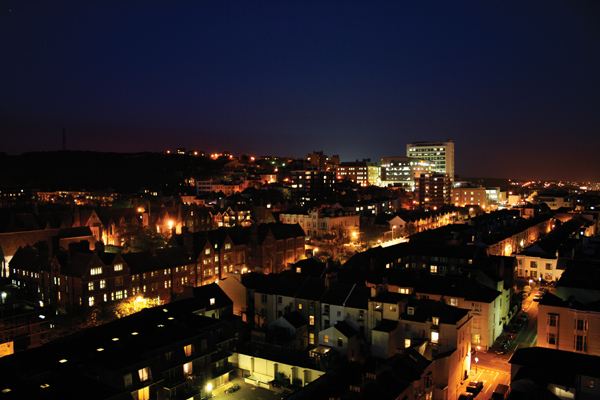Hospital prepares for winter strain
Falls, fractures and flu are just a few of the factors placing extra pressure on the NHS at Christmas. Frank le Duc reports

As winter comes around every year, it may seem surprising that health chiefs feel the need to put together a “winter plan”. But they do. The reason is simple. We know that we will probably have at least one or two cold snaps – and this winter we’ve already had the first – but we don’t know exactly when. And when those cold snaps happen, several strains can quickly begin to tell on the NHS.
When it’s icy or it snows, more people tend to slip over. The rise in broken bones, dislocated bones and torn ligaments takes its toll. Some of those with respiratory conditions can be more likely to suffer breathing problems. Flu often rears its head, with the elderly and the very young usually considered to be most at risk.
Then there’s the winter vomiting bug – norovirus – which has added to the pressure on beds at the Royal Sussex County Hospital in Brighton over the past few months. Bristol and Vallance wards were affected. But care homes and nursing homes aren’t exempt from its effects. And it can take longer than most of us might expect for the all-clear to be given.
Nikki Luffingham, chief operating officer at the trust which runs the Royal Sussex, told its monthly board meeting: “Closing beds for norovirus has had a huge impact.” She said that losing even a few beds for just one day had a knock-on effect. When longer closures are necessary, especially involving a whole ward, the effect is magnified.
When the weather does take a turn for the worse and people are struggling to make it to work, doctors and nurses are also affected.
While a mini medical village sometimes appears to have evolved around the Royal Sussex, many of the 6,500 staff travel in from much further afield and not all from places with good public transport links.
Added pressures
Some aspects of winter are, of course, entirely predictable, such as the date of Christmas and the new year. But health statisticians have found that the day of the week on which Christmas falls can also make a difference. When it creates a three or four-day break, there is often a bulge in the number of patients turning up at the hospital Accident and Emergency Department (A&E) on the first working day back.
Another pressure comes from people wanting to be with their families at Christmas, including doctors and nurses as well as support staff. Family doctors’ surgeries may be closed completely or open for fewer sessions than usual over the Christmas and new year period. And there has been a growing tendency among patients to call an ambulance or head straight to A&E.
It’s probably no surprise that agencies often charge a premium for staff over bank holidays, such as Christmas Day, Boxing Day and New Year’s Day. This reflects the lower availability of locums and agency nurses. Similar factors affect the hospital’s ability to discharge patients who could be cared for in the community, say, in a rehabilitation unit or a care home or nursing home. Pressure on staffing levels – not just their own – can leave the hospital with fewer options than usual.
While the festive season is a time of joy and celebration for many, it can be tougher than usual for those suffering from mental health problems and addictions. Some of the loneliest and most isolated people around us can fall into depression and even become suicidal. Efforts have been made to improve access to psychiatric treatment when patients arrive in A&E but there are still unsurprisingly sometimes strains on the system.
So while NHS bureaucrats often have a negative image, those at the Royal Sussex are busy trying to make sure that they and their medical colleagues have vital information at their fingertips. This includes a detailed analysis of the peaks in demand to try to predict when they are most likely to occur. It also includes knowing exactly how many patients are in the hospital and where – and whether any beds are free or whether any beds could soon become free.
If patients are discharged too soon, they may end up being readmitted. This is a situation that everyone involved tries to avoid. It’s not good for the hospital and it’s usually even worse for the patient.
Winter planning
At a recent meeting, Nikki Luffingham and her deputy Daniel de Rozarieux told the board of Brighton and Sussex University Hospitals NHS Trust about their approach to winter planning. They said that it was intended “to ensure that service disruption is minimal and standards sustained across the health economy”. They added that the trust “also has a plan to ensure staff can access sites, and services run safely through agreed escalation procedures during adverse weather”.
They said in a paper presented to the board: “The system or ‘winter plan’ sets out the expectations and contingency arrangements agreed across the Brighton and Hove local health economy to ensure appropriate management of anticipated and unplanned peaks in demand.”
The hospital trust has agreed five priorities with the clinical commissioning groups – the newly formed committees of family doctors who set priorities and decisions. The aim is to ensure that patients are seen in the appropriate setting, at the right time and receive the best care. The five priorities are:
• Accessible and responsive community services
• Effective multi-disciplinary team working and discharge planning in hospital
• Prevention of avoidable admissions to hospital
• Establishment of an integrated hospital discharge team
• Co-ordination of improvements in older people mental health, including long-term care placements and support.
If it seems as though there is an emphasis on treating patients in the community as opposed to in A&E, there are a number of reasons for this. One reason is that many patients are not seriously ill or injured enough to need the services of an emergency doctor or nurse. They would be better off being seen by their family doctor or at the walk-in centre in Queen’s Road, a few yards from Brighton Station. Another reason is cost.
The walk-in centre is open from 8am to 8pm every day of the year. Unlike most GP surgeries, the walk-in centre is open on Sundays and every bank holiday. Many people would be better off heading there than to A&E and would face much less of a wait.
While patients can register there, one of the aims of creating walk-in centres was to offer treatment to those who weren’t registered or who weren’t close to where they were registered. In a town with millions of tourists and other visitors every year as well as thousands of students, this is a valuable asset.
The cost of treating a patient at the walk-in centre is much less than in A&E although slightly more than in a traditional GP surgery. Most GP surgeries, though, just aren’t open anything like as long as the walk-in centre. And many patients prefer to be waiting in a place where qualified medical staff are working rather than waiting at home for an out of hours doctor to arrive. The walk-in centre’s value is almost certainly greater than its cost.
The hospital trust board found that even in the medical community as well as among the public there was a high level of ignorance about the presence of the walk-in centre. The hospital trust board was told that clinical commissioning group would run an advertising campaign to help tackle this. Some patients will turn to their pharmacist or even the NHS Direct phone line or website. But hospital bosses were clear on one point – they don’t want to see you in A&E this Christmas unless you really have to be there.



















